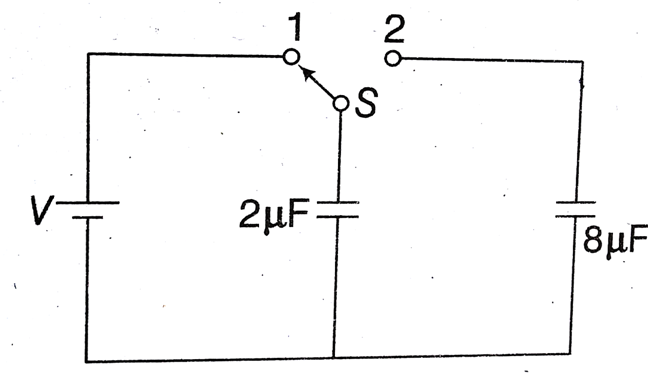 Multiple Choice Questions
Multiple Choice QuestionsA capacitor of 2 is charged as shown in the figure. When the switch s is turned to position 2, the percentage of its stored energy dissipated is,
is charged as shown in the figure. When the switch s is turned to position 2, the percentage of its stored energy dissipated is,

20%
75%
80%
80%
A parallel plate air capacitor of capacitance C is connected to a cell of emf V and then disconnected from it. A dielectric slab of a dielectric slab of dielectric constant K, which can just fill the air gap of the capacitor, is now inserted in it. which of the following is incorrect?
The potential difference between the plates decreases K times
The energy stored in the capacitor decreases K times
The change in energy stored is 
The change in energy stored is 
A potentiometer wire has length 4 m and resistance 8Ω. The resistance that must be connected in series with the wire and an accumulator of emf 2V, so as to get a potential gradient 1mV per cm on the wire is
32Ω
40Ω
44Ω
44Ω
Across a metallic conductor of non-uniform cross -section, a constant potential difference is applied. The quantity which remains constant along the conductor is
Current density
Current
drift velocity
drift velocity
A parallel plate capacitor has a uniform electrinc field E in the space between the plates. If the distance between the plates is d and area of each plate is A, the energy storedf in the capacitor is df and area of each plate is A, the energy stored in the capacitor is




Two metallic spheres of radii 1 cm and 3 cm are given charges of (-1 x 10-2 C) and 5 x 10-2 C , respectively. If these are connected by a conducting wire, the final charge on the bigger sphere is
2 x 10-2 C
3 x 10-2 C
4 x 10-2 C
4 x 10-2 C
The potential energy of a particle in a force field is, where A and B are positive constants are r is the distance of a particle from the centre of the field. For stable equilibrium, the distance of a particle is
where A and B are positive constants are r is the distance of a particle from the centre of the field. For stable equilibrium, the distance of a particle is
B/2A
2A/B
A/B
A/B
Four point charge -Q,-q,2q and 2Q are placed, one at each corner of the square. The relation between Q and q for which the potential at the centre of the square is zero is
Q= -q
Q=-1/q
Q=q
Q=q
A, B and C are three points in a uniform electric field. The electric potential is
 E
EMaximum at A
Maximum at B
Maximum at C
Maximum at C
A parallel plate condenser has a uniform electric field E (V/m) in the space between the plates. If the distance between the plates is d(m) and area of each plate is A(m2) the energy (joule) stored in the condenser is




